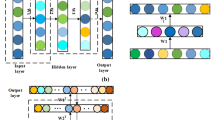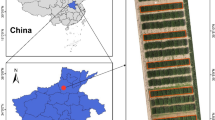Abstract
Remote sensing approaches are of increasing importance for agricultural applications, particularly for the support of selective agricultural measures that increase the productivity of crop stands. In contrast to multi-spectral image data, hyperspectral data has been shown to be highly suitable for the detection of crop growth anomalies, since they allow a detailed examination of stress-dependent changes in certain spectral ranges. However, the entire spectrum covered by hyperspectral data is probably not needed for discrimination between healthy and stressed plants. To define an optimal sensor-based system or a data product designed for crop stress detection, it is necessary to know which spectral wavelengths are significantly affected by stress factors and which spectral resolution is needed. In this study, a single airborne hyperspectral HyMap dataset was analyzed for its potential to detect plant stress symptoms in wheat stands induced by a pathogen infection. The Bhattacharyya distance (BD) with a forward feature search strategy was used to select relevant bands for the differentiation between healthy and fungal infected stands. Two classification algorithms, i.e. spectral angle mapper (SAM) and support vector machines (SVM) were used to classify the data covering an experimental field. Thus, the original dataset as well as datasets reduced to several band combinations as selected by the feature selection approach were classified. To analyze the influence of the spectral resolution on the detection accuracy, the original dataset was additionally stepwise spectrally resampled and a feature selection was carried out on each step. It is demonstrated that just a few phenomenon-specific spectral features are sufficient to detect wheat stands infected with powdery mildew. With original spectral resolution of HyMap, the highest classification accuracy could be obtained by using only 13 spectral bands with a Kappa coefficient of 0.59 in comparison to Kappa 0.57 using all spectral bands of the HyMap sensor. The results demonstrate that even a few hyperspectral bands as well as bands with lower spectral resolution still allow an adequate detection of fungal infections in wheat. By focusing on a few relevant bands, the detection accuracy could be enhanced and thus more reliable information could be extracted which may be helpful in agricultural practice.








Similar content being viewed by others
References
Apan, A., Held, A., Phinn, S., & Markley, J. (2004). Detecting sugarcane ‘orange rust’ disease using EO-1 Hyperion hyperspectral imagery. International Journal of Remote Sensing, 25, 489–498.
Bhattacharyya, A. (1943). On a measure of divergence between two statistical populations defined by probability distributions. Bulletin of the Calcutta Mathematical Society, 35, 99–109.
Bongiovanni, R., & Lowenberg-Deboer, J. (2004). Precision agriculture and sustainability. Precision Agriculture, 5, 359–387.
Bravo, C., Moshou, D., West, J. S., McCartney, A., & Ramon, H. (2003). Early disease detection in wheat fields using spectral reflectance. Biosystems Engineering, 84, 137–145.
Breiman, J. (1984). Classification and regression trees. Florida: CRC Press LLC.
Chang, C.-C., & Lin, C.-J. (2001). LIBSVM: A library for support vector machines. Available at http://www.csie.ntu.edu.tw/~cjlin/libsvm. Accessed 12 Apr 2010.
Chen, G. Y., & Qian, S. E. (2008). Evaluation and comparison of dimensionality reduction methods and band selection. Canadian Journal of Remote Sensing, 34, 26–32.
Commission, European. (2008). Agriculture in the European Union, statistical and economic information 2008. Belgium: Brussels.
Congalton, R. G., & Green, K. (1999). Assessing the accuracy of remotely sensed data: Principles and practices. Boca Raton: CRC Press.
Dalponte, M., Bruzzone, L., Vescovo, L., & Gianelle, D. (2009). The role of spectral resolution and classifier complexity in the analysis of hyperspectral images of forest areas. Remote Sensing of Environment, 113, 2345–2355.
De Backer, S., Kempeneers, P., Debruyn, W., & Scheunders, P. (2005). A band selection technique for spectral classification. IEEE Geoscience and Remote Sensing Letters, 2, 319–323.
DeFries, R. S., & Chan, J. C. W. (2000). Multiple criteria for evaluating machine learning algorithms for land cover classification from satellite data. Remote Sensing of Environment, 74, 503–515.
Franke, J., & Menz, G. (2007). Multi-temporal wheat disease detection by multi-spectral remote sensing. Precision Agriculture, 8, 161–172.
Franke, J., Mewes, T., & Menz, G. (2008). Airborne hyperspectral imaging for the detection of powdery mildew in wheat. San Diego: Proceeding SPIE Optics & Photonics 2008.
Franke, J., Mewes, T., & Menz, G. (2009). Requirements on spectral resolution of remote sensing data for crop stress detection. Cape Town: IEEE International Geoscience and Remote Sensing Symposium, 2009.
Goetz, A. F. H. (2009). Three decades of hyperspectral remote sensing of the Earth: A personal view. Remote Sensing of Environment, 113, 5–16.
Herold, M., Gardner, M. E., & Roberts, D. A. (2003). Spectral resolution requirements for mapping urban areas. IEEE Transactions on Geoscience and Remote Sensing, 41, 1907–1919.
Jimenez, L. O., & Landgrebe, D. A. (1999). Hyperspectral data analysis and supervised feature reduction via projection pursuit. IEEE Transactions on Geoscience and Remote Sensing, 37, 2653–2667.
Keshava, N. (2004). Distance metrics and band selection in hyperspectral processing with applications to material identification and spectral libraries. IEEE Transactions on Geoscience and Remote Sensing, 42, 1552–1565.
Kohavi, R., & John, G. H. (1997). Wrappers for feature subset selection. Artificial Intelligence, 97, 273–324.
Kruse, F. A., Lefkoff, A. B., Boardman, J. W., Heidebrecht, K. B., Shapiro, A. T., Barloon, P. J., et al. (1993). The spectral image-processing system (Sips)—interactive visualization and analysis of imaging spectrometer data. Remote Sensing of Environment, 44, 145–163.
Kruse, F. A., Boardman, J. W., & Huntington, J. F. (2003). Comparison of airborne hyperspectral data and EO-1 Hyperion for mineral mapping. IEEE Transactions on Geoscience and Remote Sensing, 41, 1388–1400.
Kühbauch, W., & Hawlitschka, S. (2003). Remote sensing—a future technology in precision farming. In H. Lacoste (Ed.), Proceedings of the workshop on POLinSAR 2003—applications of SAR polarimetry and polarimetric interferometry (pp. 25.1–25.10, CDROM). Frascati, January 14–16, 2003.
Landis, J. R., & Koch, G. G. (1977). Measurement of observer agreement for categorical data. Biometrics, 33, 159–174.
Lorenzen, B., & Jensen, A. (1989). Changes in leaf spectral properties induced in barley by cereal powdery mildew. Remote Sensing of Environment, 27, 201–209.
Lu, S., Oki, K., Shimizu, Y., & Omasa, K. (2007). Comparison between several feature extraction/classification methods for mapping complicated agricultural land use patches using airborne hyperspectral data. International Journal of Remote Sensing, 28, 963–984.
Meier, U. (2001). Growth stages of mono- and dicotyledonous plants. http://www.jki.bund.de/de/startseite/veroeffentlichungen/bbch-codes.html. Accessed 12 Apr 2010.
Mewes, T., Franke, J., & Menz, G. (2008). Multitemporal spectroscopy for crop stress detection using band selection methods. In S.S. Shen & P.E. Lewis (Eds.), Proceedings of SPIE, the international society for optical engineering, optics & photonics 2008 (vol. 7086, pp. 70860A.1–9). San Diego, August 12–13, 2008.
Mewes, T., Franke, J., & Menz, G. (2009). Data reduction of hyperspectral remote sensing data for crop stress detection using different band selection methods. In H. Annegarn (Ed.), Proceedings of IEEE International Geoscience and Remote Sensing Symposium 2009 (pp. 463–466, CDROM). Cape Town: IGARSS, July 12–17, 2009.
Miao, X., Gong, P., Swope, S., Pu, R. L., Carruthers, R., & Anderson, G. L. (2007). Detection of yellow starthistle through band selection and feature extraction from hyperspectral imagery. Photogrammetric Engineering and Remote Sensing, 73, 1005–1015.
Rabe, A., Van der Linden, S., & Hostert, P. (2009). imageSVM, Version 2.0. Available at http://www2.hu-berlin.de/hu-geomatics/projects/imageSVM.php. Accessed 12 Apr 2010.
Serpico, S. B., & Bruzzone, L. (2001). A new search algorithm for feature selection in hyperspectral remote sensing images. IEEE Transactions on Geoscience and Remote Sensing, 39, 1360–1367.
Van der Linden, S., Rabe, A., Okujeni, A., & Hostert, P. (2009). Image SVM classification, application manual: Image SVM version 2.0. Available at http://www2.hu-berlin.de/hu-geomatics/projects/imageSVM.php. Accessed 12 Apr 2010.
Vapnik, V. (1998). Statistical learning theory. New York: John Wiley and Sons Inc.
Waske, B., & Benediktsson, J. A. (2007). Fusion of support vector machines for classification of multisensor data. IEEE Transactions on Geoscience and Remote Sensing, 45, 3858–3866.
Waske, B., Van der Linden, S., Benediktsson, J.A., Rabe, A. & Hostert, P. (2009). Impact of different morphological profiles on the classification accuracy of urban hyperspectral data. In J. Chanussot & B. Luo (Eds.), Proceedings of the first IEEE GRSS Workshop on Hyperspectral Image and Signal Processing 2009, WHISPERS (pp. 1–4, CDROM). Grenoble: Grenoble Institute of Technology, 26–28 Aug 2009.
West, J. S., Bravo, C., Oberti, R., Lemaire, D., Moshou, D., & McCartney, H. A. (2003). The potential of optical canopy measurement for targeted control of field crop diseases. Annual review of Phytopathology, 41, 593–614.
Yang, C.-M. (2010). Assessment of the severity of bacterial leaf blight in rice using canopy hyperspectral reflectance. Precision Agriculture, 11, 61–81.
Acknowledgments
Data acquisition with the Hyperspectral Mapper (HyMap) was undertaken by the German Aerospace Center (DLR). These studies were carried out by Research Training Group 722 funded by the German Research Foundation (DFG).
Author information
Authors and Affiliations
Corresponding author
Rights and permissions
About this article
Cite this article
Mewes, T., Franke, J. & Menz, G. Spectral requirements on airborne hyperspectral remote sensing data for wheat disease detection. Precision Agric 12, 795–812 (2011). https://doi.org/10.1007/s11119-011-9222-9
Published:
Issue Date:
DOI: https://doi.org/10.1007/s11119-011-9222-9




